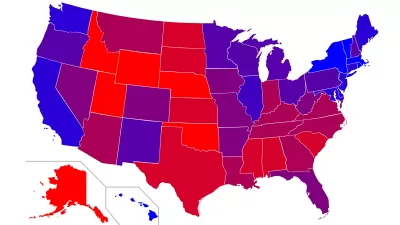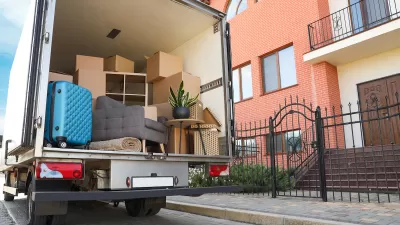New Census data shows that after a recession induced respite, "Americans have resumed moving from the Northeast and Midwest to the West and South," reports Neil Shah. Four of the nation's fastest growing large metro areas are located in Texas.
"Forty of the 50 fastest-growing metropolitan areas in the U.S. last year were in the South or West, according to a Census report to be published Thursday," writes Shah. "Of the 20 counties that saw the biggest inflows of people relative to their populations, 19 were in the West, the South or Great Plains states such as North Dakota. Meanwhile, metro areas in the Northeast and Midwest including Detroit and Philadelphia saw relatively large outflows of people between July 2011 and July 2012, the Census report shows."
"The fact that more Americans are now moving west and south could reflect improved hiring and suggests fewer people are stuck in one place because they owe more on their mortgages than their homes are worth," he adds. "Separate Census figures recently showed around 4% of the U.S. population moved to a different county in 2011, the highest level since before the recession."
"The dam has broken on the pent-up demand for migration," demographer William Frey of the Brookings Institution said. "There is the beginning of a shift back to the Sunbelt, as many Snowbelt movers who were frozen in place are now moving to South and West metropolitan areas."
An article on the new figures in The Washington Post, which notes that the region's remarkable growth has slowed considerably, shows a ranking of the 15 fastest growing large metros.
FULL STORY: Americans on the Move Again

Study: Maui’s Plan to Convert Vacation Rentals to Long-Term Housing Could Cause Nearly $1 Billion Economic Loss
The plan would reduce visitor accommodation by 25,% resulting in 1,900 jobs lost.

North Texas Transit Leaders Tout Benefits of TOD for Growing Region
At a summit focused on transit-oriented development, policymakers discussed how North Texas’ expanded light rail system can serve as a tool for economic growth.

Why Should We Subsidize Public Transportation?
Many public transit agencies face financial stress due to rising costs, declining fare revenue, and declining subsidies. Transit advocates must provide a strong business case for increasing public transit funding.

Dear Tesla Driver: “It’s not You, It’s Him.”
Amidst a booming bumper sticker industry, one writer offers solace to those asking, “Does this car make me look fascist?”

A Visual Celebration of Manhattan’s Chinatown Elder Community, Through Food
Lanterns, cafeteria trays, and community connection take center stage in this stunning photo essay.

How to Make US Trains Faster
Changes to boarding platforms and a switch to electric trains could improve U.S. passenger rail service without the added cost of high-speed rail.
Urban Design for Planners 1: Software Tools
This six-course series explores essential urban design concepts using open source software and equips planners with the tools they need to participate fully in the urban design process.
Planning for Universal Design
Learn the tools for implementing Universal Design in planning regulations.
City of Santa Clarita
Ascent Environmental
Institute for Housing and Urban Development Studies (IHS)
City of Grandview
Harvard GSD Executive Education
Toledo-Lucas County Plan Commissions
Salt Lake City
NYU Wagner Graduate School of Public Service





























